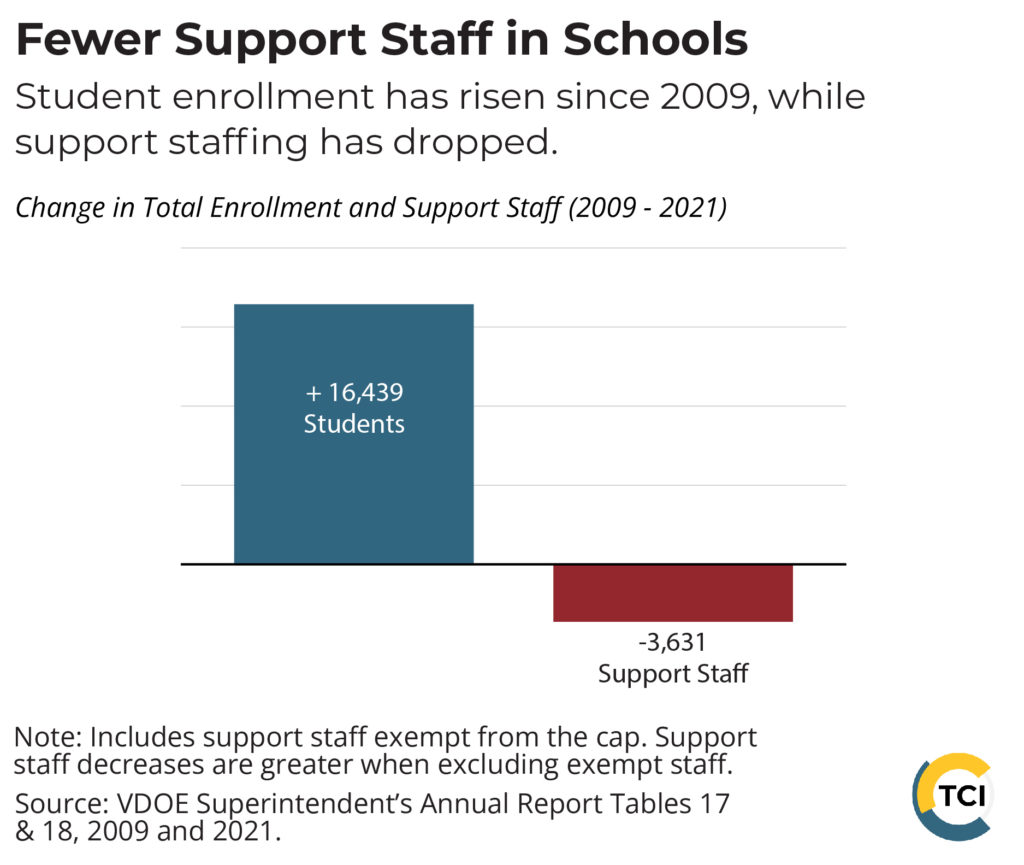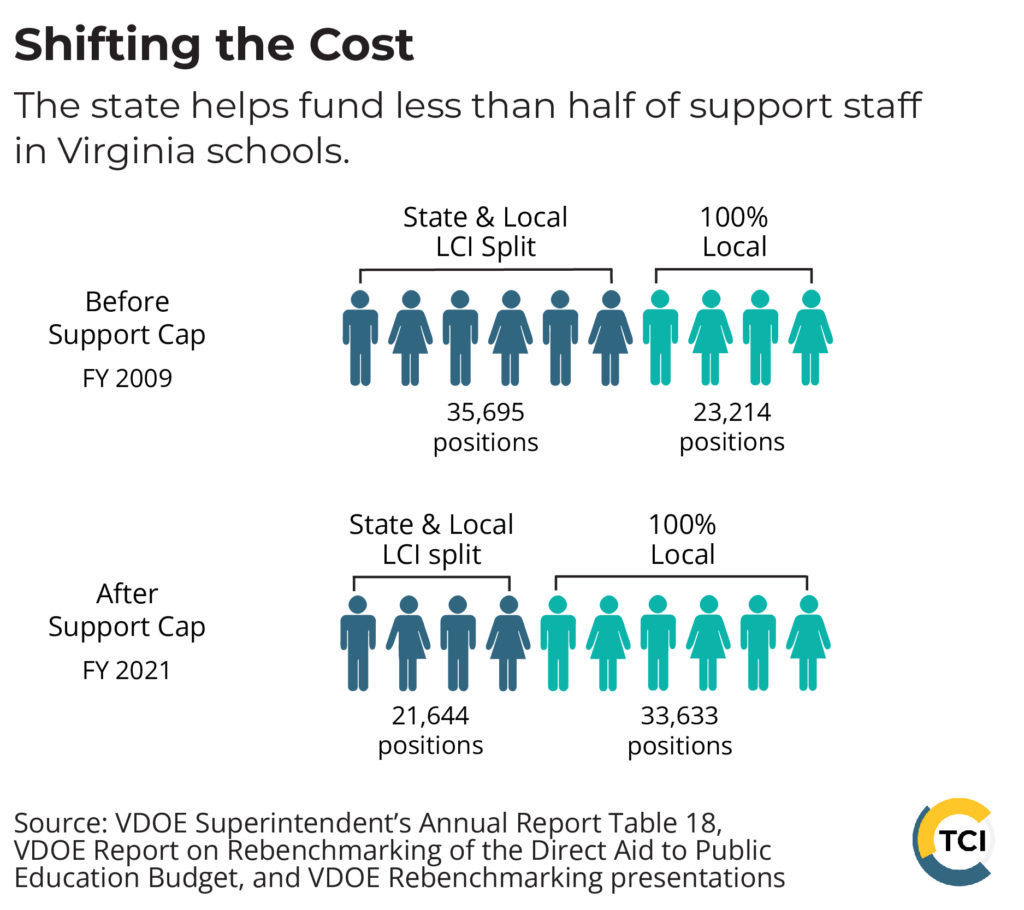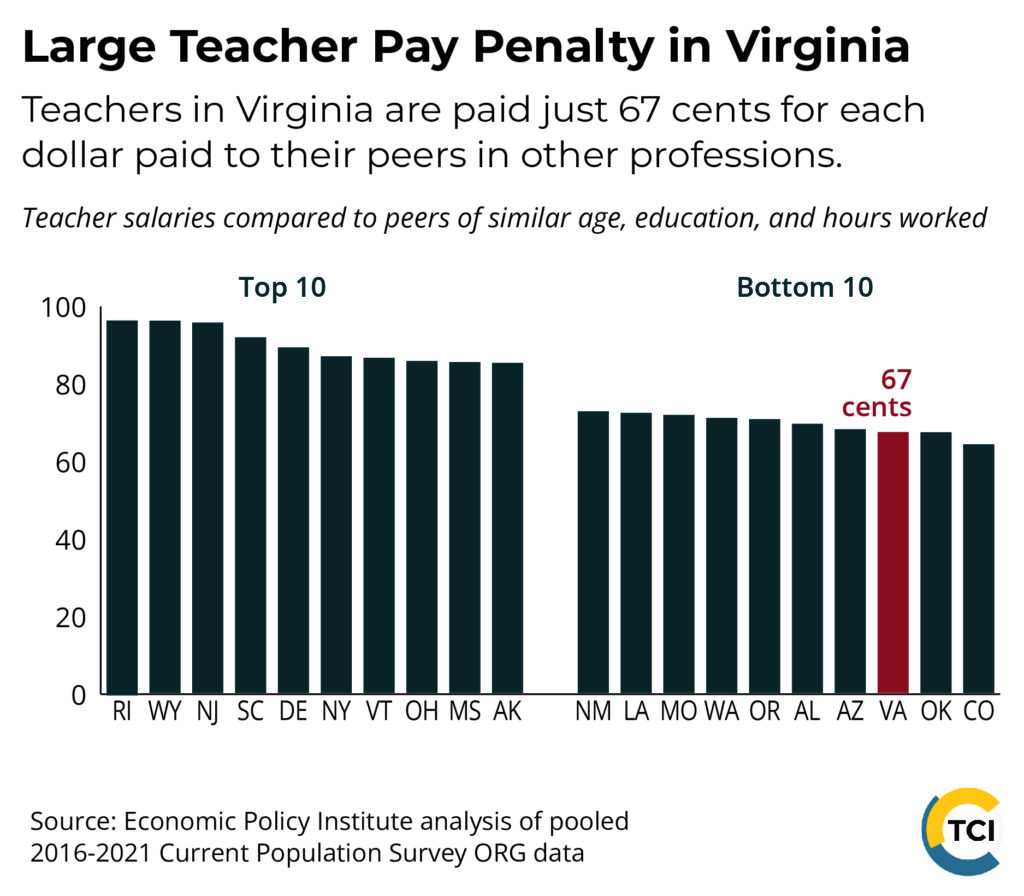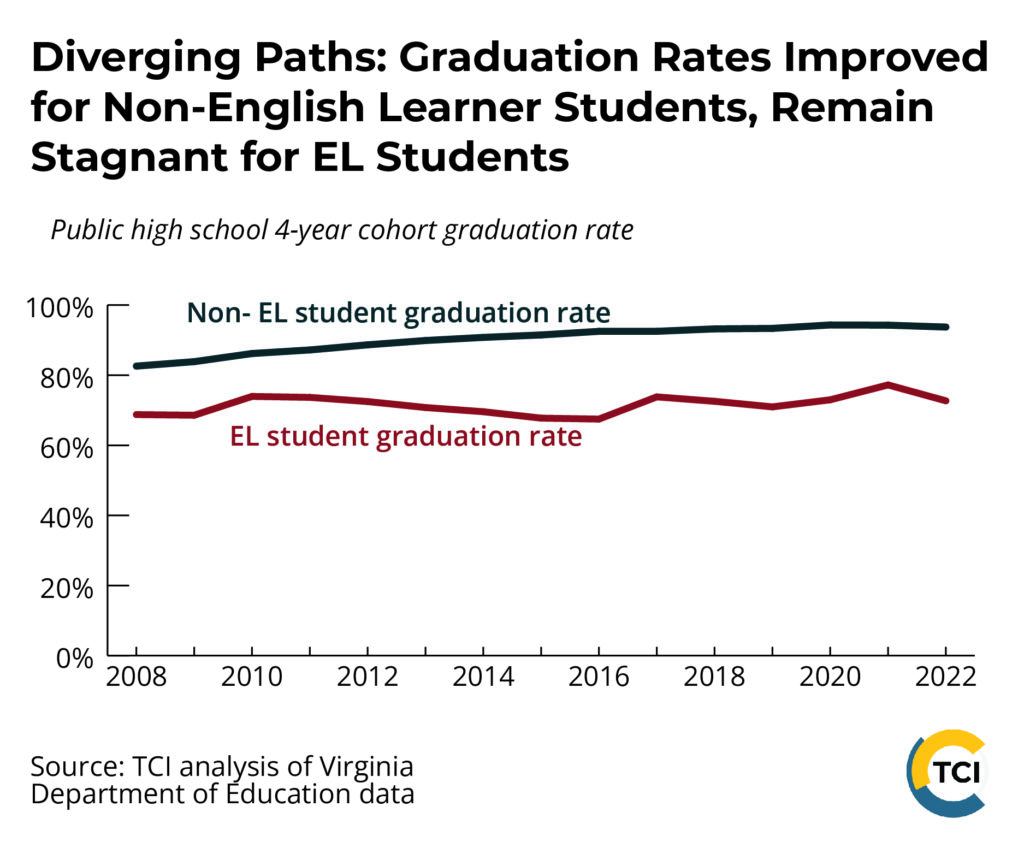January 22, 2023
State Policymakers Must Fulfill Virginia’s Commitment to Our Students
The Quick-Take
The Problem
Too many Virginia children go to schools that don’t have sufficient resources to provide a high-quality education and make sure every student can learn and thrive. Students, parents, and teachers in communities across Virginia are working hard, yet in many communities they do so without access to sufficient funding from the state.
The Cause
Despite some recent progress, the state of Virginia still provides even less funding for schools than its own Board of Education says is needed to provide a high-quality education. While some localities can afford to make up the difference, that’s not true in many parts of Virginia. As a result, students in higher poverty communities continue to be excluded from a top-quality education.
The Solution
Virginia policymakers should fully fund the state’s share of the cost of providing a high-quality education. As a first step, that means fully funding the Board-prescribed Standards of Quality, lifting the arbitrary cap on state funding for support staff, and investing in teacher and staff salaries, while making additional targeted investments. Longer term, policymakers should commission an independent, nonpartisan study of the true cost of providing a high-quality education for every student and then fund its fair share of those costs.

No matter who we are or where we were born, we all want our communities to have high-quality public schools where every child can thrive. Virginia policymakers have the opportunity to take significant steps toward that goal by finally lifting the arbitrary cap on state funding for support staff, providing the state’s share of what Virginia’s own Board of Education says is needed for a high-quality education, and making targeted investments to help students who are struggling the most.
Thanks to the hard work of students, teachers, and parents, many of Virginia’s students are doing well despite the tremendous challenges of the past few years. But the state isn’t doing its part to make sure every student in every zip code has access to a great education. Virginia has the capacity to do well – we’re a top 10 state in terms of median household income – but we’re 40th in the country in state funding per student. In some places, local governments can and do make up for the state’s failings, but in many lower-income communities, local governments don’t have the capacity to do so.
And to make matters worse, some powerful politicians are trying to divide us and root against our schools to justify diverting public money to private school vouchers for the wealthy. The state must reject counterproductive voucher schemes and must fulfill our commitments to Virginia’s schools before even considering tax breaks for profitable corporations and wealthy individuals. Public schools are the foundation of a strong multiracial democracy, and we know what it takes to make sure every student has access to a high-quality education. Decades of high-quality research shows that money matters for student outcomes. By working together, we can make sure policymakers put our shared resources toward creating great public schools in every community.
Where we stand: Some Progress, Far to Go
Great public schools that educate children from varying backgrounds are the cornerstone of thriving communities, a strong modern economy, and a thriving multiracial democracy. Unfortunately, before the 2022 legislative session, the state of Virginia was still investing less — on a per-student basis — in our public schools than in 2009 after adjusting for inflation. To this day, the state is still investing less than its own Board of Education says is needed and falling short of our constitutional responsibilities to “seek to ensure that an educational program of high quality is established and continually maintained.” By any measure, the state of Virginia is not doing what it can and should to provide a high-quality education for every student.
Several recent studies have documented Virginia’s school funding failures:
- Virginia received “D grades” for adequacy and equity in combined state and local school funding and an “F grade” in funding effort from the Education Law Center.1
- “Virginia is a low effort state” with “highly unequal” educational opportunity, according to a study of school finances by researchers at Rutgers University, the University of Miami, and the Shanker Institute for the 2019-2020 school year.2
- Virginia school divisions serving the most students of color receive $722 or 5% less state and local revenue per student than districts serving the fewest students of color, according to a study by The Education Trust.3
Standards of Quality
Each year, Virginia’s Board of Education prescribes standards that outline the level of support, including the number of staff, needed to provide a high-quality education, known as the Standards of Quality (SOQs). Despite some progress this past year, Virginia policymakers have not yet invested even what the state’s own board has long said is needed.
Research shows us that increasing the adequacy and equity in per-pupil funding — providing full and fair funding — positively impacts student achievements. According to one recent meta-analysis of every “credibly causal” study of the effects of public K-12 school spending on student outcomes in the United States, an additional $1,000 for at least four years significantly increases test scores, high school graduation, and college enrollment.4
Fully funding Virginia’s Board of Education-prescribed SOQs would increase state support for school counselors, instructors for students who are not fully proficient in English and need additional services (English learners), assistant principals, physical and behavioral health providers (specialized student support positions), and much more. Specifically, it would provide the state share of about 1,490 more assistant principals, 1,200 more physical and behavioral health providers, 1,100 more school counselors, and about 700 more instructors of English learners. Having trained professionals in our schools to listen and guide students, particularly those experiencing severe trauma, is essential for addressing both the impact of the COVID-19 pandemic and other stressors on student mental health.
Conversely, failing to fund the state’s share of the costs of employing these teachers and other school staff has meant that some of Virginia’s students who need the most help continue to be excluded from a high-quality education. During the 2021-2022 school year, Virginia’s additional funding for instructors for English learners (EL) averaged just $725 per EL student, representing a 13.5% state supplement — a low level of support compared to the national average of 39%.5
Most states also provide additional funding for professional development and wrap-around services to help English learners reach their full potential, something Virginia does not do. As a result, English learners in Virginia face additional barriers compared to their peers in Virginia and in other states, resulting in lower test scores and lower graduation rates.
Support Cap
In addition to not fully funding the SOQs, another key way in which the state is not yet fully funding our schools is the arbitrary cap on the number of support staff that Virginia helps fund. This means that even as enrollment grew by 16,000 students from 2009 to 2021, the number of support staff in schools shrunk. Schools play a critical role in meeting a variety of needs for students and families, like help accessing community resources, meals, and after-school programming. But to adequately meet these needs, schools must have an adequate number of support staff. These critical positions include custodians to maintain a clean and safe facility, instructional aides to help children learn, front-office staff to answer parents’ questions and follow up with students who are absent, and much more. They are in a unique position to build trust with students, encourage parental and family involvement in education, improve school climate, and provide a wide range of services that are essential in meeting the academic, social, and emotional learning needs of students in and out of the classroom.


The support cap also puts financial challenges on the budgets of local governments. The number of support staff positions that the state will help fund has fallen even faster than overall support staff positions, pushing more of the financial cost onto cities and counties. As of the 2020-2021 school year, the state helped pay for less than 40% of support staff in Virginia’s public schools, down from 61% in 2008-2009. Many local governments have had to fund the majority of these positions on their own, and not all localities have sufficient resources to make these investments. And in years when the state offers a pay raise, like the 5% annual increase in fiscal years 2023 and 2024, state dollars are only provided for the number of support positions covered by the support cap, not the number of actual staff. Local governments are left with difficult choices: provide for part or all of the raise, if it can at all, or find other sources of revenue to fund a raise.
Policymakers took a major step during the 2022 legislative session by partially unwinding the arbitrary cap on state funding for support staff. Completely lifting the arbitrary support cap this year would provide the state’s share of funding for about 6,500 additional support staff and provide financial relief for school divisions and local governments that have been paying for these positions without state help.
Teacher Pay
Virginia students and schools are also harmed by recruitment and retention problems due to low pay for teachers and other school staff. Effective teachers are the most important school-based factor that contributes to academic achievement. Yet Virginia had the third-worst teacher pay penalty in the country in 2021, with Virginia teachers being paid 32.7% less — just 67 cents for each dollar — compared to their peers with similar education levels in other professions. And average teacher pay in Virginia ($60,880 in 2020-2021) is almost 10% below the national average ($67,507 that same year), even before adjusting for state differences in typical pay for professionals in other fields. High vacancy rates in a wide variety of school positions – from bus drivers to middle school reading specialists to speech-language pathologists – further point to the challenges created for students and communities when pay is insufficient to compete with other jobs and support a family.

Virginia policymakers worked to respond to this challenge by including the state share of a 5% teacher pay raise this school year and next in the budget they passed during the 2022 special session. However, these increases likely will not be enough to keep up with either the growing cost of living or the rising salaries of teachers in other states and other professionals in Virginia. Teachers and staff are a critical part of public schools and student success. Additional investment is needed for Virginia teacher pay to catch up to the national average and have wages that are competitive with their peers in other professions. This year, policymakers can use $329 million of Virginia’s available general funds to pay the state’s share of an 11% raise for teachers and school staff (up from the 5% already approved for the coming school year), which would raise Virginia’s teacher pay to about the national average for the upcoming school year.
Removing Barriers for Students Attending High-Poverty Schools
One area where Virginia has made significant progress in recent years is in state support for school divisions that serve the most students from low-income families. Students in high-poverty schools — many of whom have fewer resources and supports outside of the school building — benefit from additional funding to overcome the unique barriers they face. To achieve national average outcomes in very high-poverty districts (poverty rates over 40%), states need to invest more than 3 times the amount per pupil as it does in relatively low poverty districts (poverty rates under 10%), according to a 2018 study from researchers at Rutgers University.6 While Virginia is far from this standard, or even the more modest cost of 2 to 3 times the base funding that some other studies estimate,7 policymakers have increased Virginia’s program for high-poverty schools – known as the at-risk add-on – to a maximum 36% more funding for each student who is eligible for free lunch in the highest-poverty school divisions. That’s a major improvement from the 12% maximum add-on in the 2015-2016 school year. While even the maximum 36% add-on is insufficient to provide enough additional services to make up for the additional barriers faced by children from low-income families, Virginia’s progress in this area is an important step forward.
School Construction
Students in Virginia deserve to learn in modern buildings that are safe and accessible to everyone. Virginia has also begun reinvesting in school maintenance and construction after many years. During the 2022 legislative session, Virginia policymakers approved $1.25 billion toward school construction and renovation needs, including $400 million in grants from the general fund that were appropriated for school construction, $450 million in competitive grants for construction and modernization from the general fund ($400 million) and literary fund ($50 million), and an allocation of $400 million from the Literary Fund for low-interest school construction loans after many years in which the state Literary Fund was primarily used for other purposes such as offsetting teacher retirement costs.
Unfortunately, the backlog of school maintenance and construction needs is significant, with over half of school buildings over 50 years old, 22% not compliant with the Americans with Disabilities Act, and 40% at or above capacity, and many school divisions in economically struggling communities – both rural and urban – do not have the fiscal capacity to fix these problems without additional state help. Addressing the deferred maintenance and construction backlog will require a multipronged approach, including additional state funding, particularly for communities with the least fiscal ability to fund their own improvements, and additional authority for local counties and cities to raise their own revenue to meet the needs of their schools.
Opportunity for Progress This Year
After years of state underfunding, communities across the commonwealth would benefit from better-funded public schools and extra help for students, particularly in those areas, both rural and urban, where local governments can least afford to make up the difference from lack of state funding. Virginia policymakers have several opportunities in 2023 to support our students and teachers. Finally fully funding the Board of Education’s prescribed Standards of Quality (SOQs) for a high-quality education and lifting the arbitrary cap on state funding for support staff would provide the state share of funding for about 1,490 more assistant principals, 1,200 more physical and behavioral health providers, 1,100 more school counselors, 700 more instructors of English learners, and about 6,500 additional support staff. Policymakers also have opportunities to seriously address retention and recruitment problems through a long-term commitment to raising teacher and staff pay, while making targeted investments in additional areas of high need such as deteriorating school facilities and critical supports for English learner students. These policy choices would also provide financial relief for school divisions and local governments that have been paying for these positions without state help.
Funding the SOQs and lifting the support cap could add:
1,490
assistant principals
1,200
physical and behavioral health providers
1,100
school counselors
700
instructors of English learners
6,500
support staff
Policymakers can take additional steps to address the particular barriers facing English learners and bring Virginia closer to the national standard in helping every student reach their full potential. During the 2023 legislative session, this includes proposals to provide additional support for English learner students enrolling in career and college readiness programs and incentivize more public school teachers to obtain endorsement for English as a Second Language.
Creating great schools in every community requires state investment. Together, lifting the arbitrary cap on state funding for support staff, funding the Board-prescribed SOQs, and providing the state share of an additional 6% salary increase for the teachers and other school staff would cost about $1 billion for the upcoming 2023-2024 school year. The good news is that Virginia already has the resources to make this investment – policymakers just need to choose to do so. Fully and fairly funding Virginia’s schools must come before tax breaks for profitable corporations and wealthy individuals. Policymakers should also reject proposals that provide public dollars for private schools, whether in the form of expanded tax credits or new voucher schemes.
Looking at the Long Term
Improving public schools for this upcoming school year through implementing Virginia’s Board-prescribed Standards of Quality, lifting the support cap, and raising teacher and staff pay are critical steps forward for Virginia students, yet will not be sufficient to fully fund Virginia’s schools such that every student has access to a great education. We know from national research that students facing barriers such as unstable housing, financial stress, and limited English proficiency require far more support than Virginia provides in order to thrive. For example, at minimum Virginia would need to triple the supplemental funding it currently provides (36% above base funding) for students facing additional barriers due to low incomes in order to reach the funding levels that national experts have said is needed to provide educational opportunity for every student. A wide range of other states – including Virginia’s neighbors in Kentucky, North Carolina, Tennessee, Maryland, and D.C., as well as Virginia’s competitor states such as Colorado – have commissioned studies to determine how much is needed to truly provide educational opportunity for all students. Although Virginia has commissioned some school funding studies in the past, including as part of updating the Standards of Quality, an up-to-date, comprehensive study of how much money is needed – and how that funding should be distributed – would provide critical information to Virginia policymakers for future updates to Virginia’s school funding formula toward reaching the goal of great public schools for every student, in every zip code.
Endnotes
- Education Law Center, Making the Grade 2022 State Profiles
- Baker, B. (University of Miami); Di Carlo, M. (Albert Shanker Institute); and Weber, M. (Rutgers University), State School Finance Profiles 2019-20, published Dec 2022
- The Education Trust, The State of Funding Equity Data Tool
- Jackson, C.K. and Mackevicius, C., “The Distribution of School Spending Impact,” NBER Working Paper 28517, Jul 2021
- The Commonwealth Institute, Changing Gears: Addressing Virginia’s Persistent Lack of Support for English Learner Students, 2021
- Baker, B., Weber, M., Baker, Srikanth, A., Kim, R., and Atzbi, M., The Real Shame of the Nation, 2018
- The Education Trust, An Analysis of School Funding Equity Across the U.S. and Within Each State, 2014

